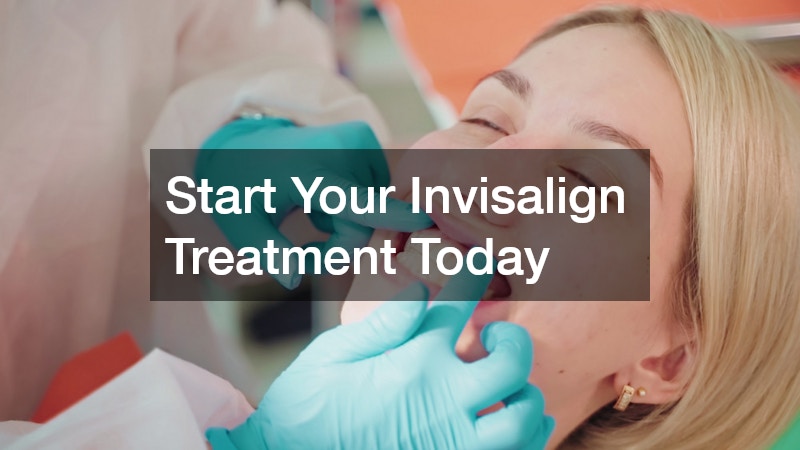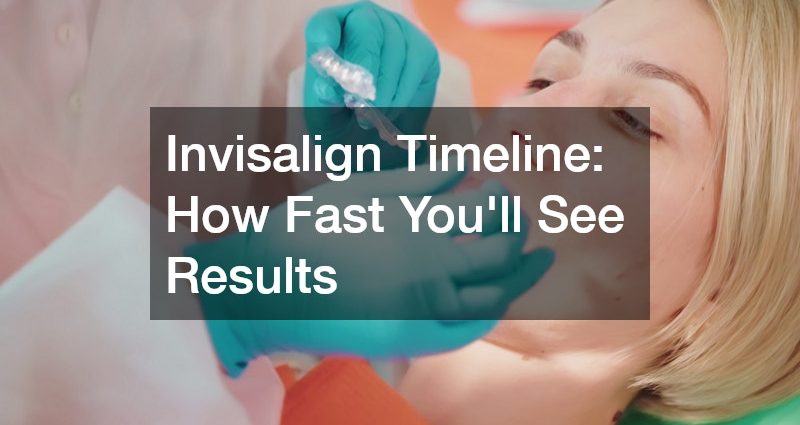
Invisalign has revolutionized orthodontic care by offering a clear, comfortable, and convenient alternative to traditional braces. Using a series of custom-made aligners, Invisalign gradually shifts your teeth into their ideal position—without metal brackets or wires. However, one of the most common questions patients ask is: How long does Invisalign take to work? The timeline for seeing results can vary depending on several factors, including the complexity of your case, your consistency in wearing aligners, and your dentist’s treatment plan.
How Long Does Invisalign Take to Work?
Typical Treatment Duration
Most Invisalign treatments last between 6 to 18 months, though minor adjustments can take as little as 3 months, and complex cases may require up to 2 years. The duration depends on factors such as the severity of misalignment, age, and how faithfully patients follow their dentist’s instructions.
Initial Changes
Patients often notice subtle changes within the first few weeks of wearing Invisalign. Teeth may begin to feel slightly different in alignment, and small gaps may start to close. These early changes are encouraging signs that the treatment is working as planned.
Tracking Progress
Orthodontists monitor your progress through digital scans and regular checkups, ensuring your teeth are moving according to plan. They may adjust the aligner sequence or recommend refinements to fine-tune your results.
Factors Affecting Timeline
The Invisalign timeline can vary based on:
-
Severity of misalignment: More complex movements take longer.
-
Wearing time: Aligners should be worn 20–22 hours daily for optimal results.
-
Age: Younger patients may experience faster movement due to more adaptable bone structures.
-
Oral habits: Smoking or frequently removing aligners can slow progress.
Success Stories and Timelines
Many patients report visible improvements within 2–3 months of starting Invisalign. Simple crowding cases may complete in under a year, while comprehensive treatments can take longer. Consistency and communication with your dentist are key to staying on track.
Why Are Attachments Used in Invisalign?
Purpose of Attachments
Attachments are small, tooth-colored bumps placed on certain teeth to help the aligners grip and move them more precisely. They act as anchors, allowing Invisalign to apply more effective pressure for complex movements.
Types of Attachments
Common attachment types include elliptical, rectangular, and beveled shapes, each designed to target specific tooth movements such as rotation, extrusion, or intrusion.
Process of Adding Attachments
Your dentist bonds attachments using a composite resin material. The process is painless and quick—usually completed in one appointment. Aligners are then designed to fit snugly over the attachments.
Effectiveness with Attachments
Attachments can significantly improve Invisalign’s effectiveness, especially in complex cases involving rotated or misaligned teeth. They ensure controlled, predictable movement, potentially shortening overall treatment time.
Patient Experience with Attachments
While attachments may feel slightly rough at first, patients typically adjust within a few days. They’re nearly invisible and require no extra maintenance beyond normal brushing and flossing.
Can You Speed Up the Invisalign Process?
Accelerating Tools and Techniques
Dentists may recommend supplemental tools like vibration devices or accelerated orthodontic systems to stimulate faster tooth movement. However, their effectiveness varies by patient.
Impact of Compliance
The single most important factor in speeding up Invisalign treatment is consistent wear. Removing aligners too often delays progress and can extend the overall timeline.
Role of Diet and Oral Hygiene
Avoiding sugary foods and maintaining excellent oral hygiene can prevent cavities and ensure treatment stays on schedule. Poor oral care can cause delays due to additional dental procedures.
Alternatives to Shorten Timeline
In some cases, Invisalign Express or limited treatment options may be available for minor alignment issues, offering faster results within just a few months.
Limitations in Accelerating Treatment
While it’s tempting to rush results, tooth movement must occur gradually to protect bone and gum health. Over-accelerating can cause root damage or discomfort, so patience is key.
What Happens During Invisalign Checkups?
Frequency of Visits
Checkups are typically scheduled every 6 to 8 weeks, allowing your dentist to assess progress and provide the next set of aligners.
Assessing Progress
At each visit, your orthodontist reviews how well your teeth are shifting and may take digital scans to track alignment progress accurately.
Making Adjustments
If certain teeth aren’t moving as planned, new aligners or additional attachments may be recommended to keep treatment on track.
Patient Questions and Concerns
Checkups also give patients the opportunity to discuss any discomfort, fit issues, or questions about daily care routines.
Continuity of Treatment
Regular visits ensure continuous progress and help prevent potential delays. Skipping checkups or failing to switch aligners on schedule can extend treatment time.
What Are Common Issues and Solutions with Invisalign?
Alignment Discomfort
Mild soreness or tightness is normal when switching to new aligners. Over-the-counter pain relief or cold water rinses can help ease discomfort.
Losing or Damaging Aligners
If aligners are lost or damaged, contact your dentist immediately. They may advise you to use the previous set or move to the next one, depending on progress.
Handling Delays in Results
Delays can occur due to inconsistent wear or biological factors. Dentists may create refinement trays to realign progress if needed.
Maintenance Challenges
Some patients find cleaning aligners or managing their use during meals challenging. Using Invisalign cleaning crystals or soaking solutions helps keep aligners clear and odor-free.
The Invisalign timeline varies from person to person, but with consistent wear, regular checkups, and good oral care, most patients begin to see noticeable results within a few months. Attachments and accelerated techniques can further enhance treatment effectiveness, while patience ensures safe and lasting outcomes. Ultimately, Invisalign offers a clear path to a straighter, more confident smile—proving that great results are worth the wait.


